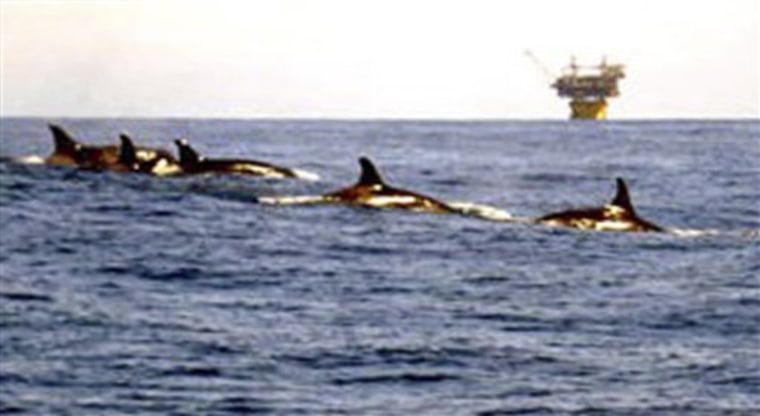It was a fish story that even veteran boat captains found fascinating: As many as 200 killer whales feeding on tuna in the warm waters of the Gulf of Mexico.
"It was like being at Sea World because they'd come right up to the boat," said Eddie Hall, captain of the Shady Lady, the 60-foot charter boat that spotted the shiny black sea beasts with white eye patches and undersides. "It was pretty neat."
It was also hard for some skeptics to believe: Orcas, as killer whales are also known, typically are thought to live in cold water and eat seals.
But Hall's description of what he saw last Oct. 31 was no tall tale: A government biologist who saw video taken from Hall's boat confirmed the captain had spotted the creatures. And last week that same scientist, Keith Mullin, explained at a public meeting in Orange Beach, Ala., that yes, contrary to common perceptions, killer whales really do live in the Gulf, far from land.
Mullin, whose outfit has been working for years to get an accurate count of the Gulf's whale population, said it may be time to dramatically increase estimates on how many killer whales are lurking in the deep waters off the Gulf Coast. He's taking part in a research expedition this summer that could determine if his hunch is right.
Scientists believe the whales have been in the Gulf for years, Mullin said, and that their presence — though startling to some anglers — isn't a sign of climate change or other manmade condition. Their relatively small population and the speed at which pods move make them difficult to count, which could have led to lower estimates.
"I've got good records of them in the Caribbean. We see them almost exclusively in deep water, 600 feet and more," Mullin said. "I think they've always been there. It's just in the last 15 to 20 years that we've been trying to study them."
Four pods seen
Hall told The Associated Press on Monday that the Shady Lady was 95 miles off the coast of Alabama when anglers and crew saw scores of the marine mammals feeding near an offshore rig in water more than a mile deep.
"There were four different pods. We estimated there were about 200 maximum. One pod had 75 in it," said Hall, who runs charters out of Zeke's Landing in Orange Beach, about 40 miles east of Mobile.
People on the boat took video and photos, including some with the offshore rig in the background to identify their location. But Hall said they got laughed off the dock when they returned.
"It was a joke because no one would believe us," he said.
Hall sent photos and video to Gary Finch, whose Fairhope-based Gary Finch Outdoors company produces a syndicated fishing and hunting television show. Finch then showed them to Mullin, who works at the Southeast Fisheries Science Center in Pascagoula, Miss., an arm of the National Oceanic and Atmospheric Administration that researches marine life.
Mullin didn't have to look twice: Hall was right about seeing killer whales, although he couldn't tell by the video how many were near Hall's boat, he said in an interview with AP.
The Shady Lady sighting "created a stir" over killer whales in the Gulf of Mexico, Mullin said; about 80 people attended the informational meeting he held in Orange Beach last week.
Diet of dolphins, tuna
Gulf orcas are just like the ones that live in cold water, Mullin said, save for their diet of dolphin and tuna instead of seals. Male killer whales average 20 feet in length and weigh as much as 12,000 pounds, but females are smaller.
Fifteen groups of killer whales have been sighted in the Gulf since deep-water surveys began in 1992, he said. Past estimates have varied widely, from a low of 49 to a high of 277 living in the Gulf north of a line extending from Key West, Fla., to Brownsville, Texas.
The actual number of killer whales in the Gulf could be closer to 500, Mullin said, and a two-month expedition this summer could help nail down an answer. The trip was planned independently of the boat's sighting, he said.
Either way, Hall's glad Mullin's outfit is involved. He knew what he saw, but he was still happy to get confirmation that his eyes weren't playing tricks on him.
